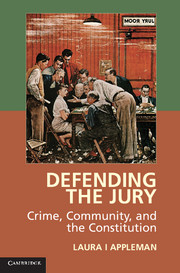Book contents
- Frontmatter
- Contents
- Acknowledgments
- 1 Introduction
- Part I History in the Crucible: Rediscovering the Original Community Right in Criminal Justice
- Part II Old Becomes New: Sixth Amendment Jury Rights and Twenty-First-Century Criminal Procedure
- Part III Theory into Practice: Origins and Community in Modern Criminal Procedure
- 6 Bail, Jail, and the Community Voice
- 7 Infusing Community through Criminal Procedure: The Plea Jury
- 8 Eradicating the Bench Trial
- 9 Restoring the Offender to Society
- 10 Back-End Sentencing: The Sixth Amendment and Post-Prison Procedures
- 11 Jury Nullification and Victim Rights: Going Past Procedure
- 12 Conclusion
- Selected Bibliography
- Index
- References
6 - Bail, Jail, and the Community Voice
Published online by Cambridge University Press: 05 April 2015
- Frontmatter
- Contents
- Acknowledgments
- 1 Introduction
- Part I History in the Crucible: Rediscovering the Original Community Right in Criminal Justice
- Part II Old Becomes New: Sixth Amendment Jury Rights and Twenty-First-Century Criminal Procedure
- Part III Theory into Practice: Origins and Community in Modern Criminal Procedure
- 6 Bail, Jail, and the Community Voice
- 7 Infusing Community through Criminal Procedure: The Plea Jury
- 8 Eradicating the Bench Trial
- 9 Restoring the Offender to Society
- 10 Back-End Sentencing: The Sixth Amendment and Post-Prison Procedures
- 11 Jury Nullification and Victim Rights: Going Past Procedure
- 12 Conclusion
- Selected Bibliography
- Index
- References
Summary
Our current framework of criminal justice has focused primarily on either a criminal offender’s fate once the trial or plea proceeding has begun or, to a lesser extent, his fate once he has been convicted and imprisoned. Until very recently, however, little attention was paid to those pretrial defendants languishing in the netherworld of jails. In part, this is due to our classification of a pretrial offender’s incarceration as “detention” as opposed to “punishment.” This chapter contends that the conditions of most pretrial detention differ little from punitive incarceration, subjecting these offenders to the worst of conditions without even a guilty verdict.
Accordingly, pretrial detainees can claim the denial of their Sixth Amendment jury trial right, which, at its broadest, forbids punishment for any crime unless a cross-section of the offender’s community adjudicates a crime and finds guilt. This chapter explores how the animating principles of the community jury trial right applies to criminal defendants who are held in pretrial detention. In doing so, I look specifically at the procedures surrounding indicted offenders who are denied bail and confined in jail.
As we explored in Chapter 3, the Supreme Court reaffirmed, in Blakely v. Washington, that a jury must determine any imposition of punishment that increases the maximum. The realities of bail and jail in today’s criminal justice system, however, dictate that punishment is often imposed by nonjury, nonjudicial, and even private actors, such as bail bondsmen, probation officers, and correction officials. In other words, conditions tantamount to punishment are imposed far from any constitutional oversight. This violates the true spirit of the Sixth Amendment jury trial right, which only permits members of the community to arbitrate punishment.
- Type
- Chapter
- Information
- Defending the JuryCrime, Community, and the Constitution, pp. 91 - 123Publisher: Cambridge University PressPrint publication year: 2015



